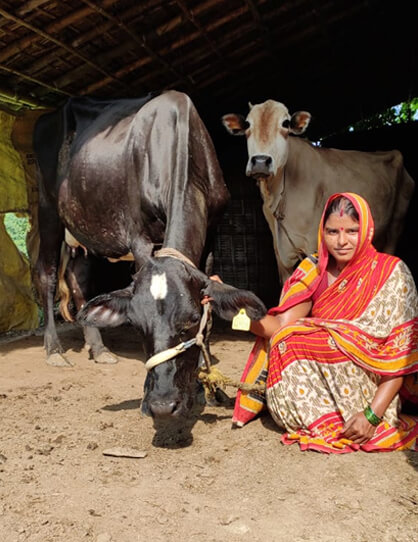 The Animal Husbandry and livestock sectors are critical for the rural economy, especially the small and marginal farmers. They not only contribute to their income but also their best insurance against any natural calamity. The advent of dairying has been a boon for dairy farmers and of particular importance to those segments of the society that have been traditionally weak, the small landholders, landless labourers and women. It has provided a year-round source of income for people who previously could only depend on payments from small seasonal crops or from occasional labour. It is estimated that up to 60-65 percent of the income of this group (marginal and small-scale farmers) now comes from dairying. Dairying in rural areas surpassed crop production in terms of profit in marginal, small and medium-sized holdings. For small-scale farmers with irrigated land, dairying and crop production together, were more profitable than crop farming alone. Over the period, dairying has also acquired the contours of a fully-fledged industry in the country and has positively improved the life of those engaged in this business, directly or indirectly, bringing significant socioeconomic changes. The Indian context for Dairy Indian agriculture is an economic symbiosis of crop and cattle population. Millions of rural smallholder milk producers dominate India’s dairy industry, contributing 62 percent of total milk produced in the country. The milch animals are fed on crop residues and milch animal dung is used as manure for crops. The dairy sector today provides 80 million farm households with the triple benefits of nutritive food, supplementary income and productive employment for family labour, mainly for women. Animal husbandry provides self-employment to millions of households in rural areas.Dairying with crossbred cattle and high-yielding buffaloes has become a lucrative business.
The Animal Husbandry and livestock sectors are critical for the rural economy, especially the small and marginal farmers. They not only contribute to their income but also their best insurance against any natural calamity. The advent of dairying has been a boon for dairy farmers and of particular importance to those segments of the society that have been traditionally weak, the small landholders, landless labourers and women. It has provided a year-round source of income for people who previously could only depend on payments from small seasonal crops or from occasional labour. It is estimated that up to 60-65 percent of the income of this group (marginal and small-scale farmers) now comes from dairying. Dairying in rural areas surpassed crop production in terms of profit in marginal, small and medium-sized holdings. For small-scale farmers with irrigated land, dairying and crop production together, were more profitable than crop farming alone. Over the period, dairying has also acquired the contours of a fully-fledged industry in the country and has positively improved the life of those engaged in this business, directly or indirectly, bringing significant socioeconomic changes. The Indian context for Dairy Indian agriculture is an economic symbiosis of crop and cattle population. Millions of rural smallholder milk producers dominate India’s dairy industry, contributing 62 percent of total milk produced in the country. The milch animals are fed on crop residues and milch animal dung is used as manure for crops. The dairy sector today provides 80 million farm households with the triple benefits of nutritive food, supplementary income and productive employment for family labour, mainly for women. Animal husbandry provides self-employment to millions of households in rural areas.Dairying with crossbred cattle and high-yielding buffaloes has become a lucrative business.
Most farmers in India are women and rural women constitute the largest group of people working on agriculture and animal husbandry. In rural areas, animal husbandry is in general considered as a job of farm women. It has been also found that women can manage the dairy animals in a better way than men. There is a general agreement that women can handle most of the critical aspects of dairy animal’s management nicely. Such aspects consist mostly of feeding, breeding, milking, cleaning, care of new born claves and sick animals. Sometimes rural women have also to manage marketing of animal’s produce and arrange the supply of feed and fodder for the cattle. The contribution of rural women towards dairy animal nutrition and fuel need of the family is as imperative as milk for sale. Rural women are well versed with each of animal’s behaviour and production characteristics. They also possess good knowledge about local feed resources for feeding of dairy animals. Although the experiences of women regarding animal diseases and production are ignored yet they can solve such problems in a nice manner.



